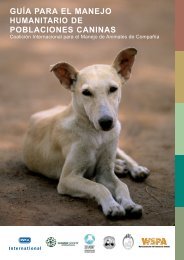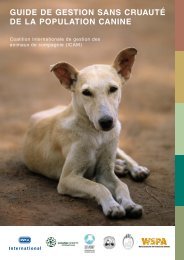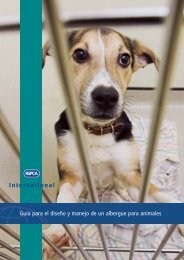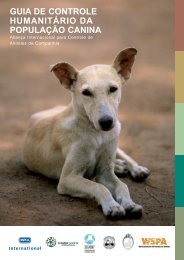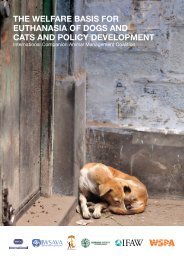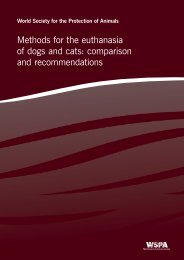HUMANE DOG POPULATION MANAGEMENT GUIDANCE - ICAM ...
HUMANE DOG POPULATION MANAGEMENT GUIDANCE - ICAM ...
HUMANE DOG POPULATION MANAGEMENT GUIDANCE - ICAM ...
Create successful ePaper yourself
Turn your PDF publications into a flip-book with our unique Google optimized e-Paper software.
e. Registration fees can be charged (a ‘one off ’ fee or<br />
payment each year) in order to provide funds for other<br />
areas of the management programme. Although care needs<br />
to be taken to balance potential income against<br />
enforcement, if fees are too high owners may try to avoid<br />
registration. Differential fee scales can be used as an<br />
incentive for sterilisation, encouraging owners to keep only<br />
a small number of animals and discouraging breeding of<br />
dogs.<br />
f. Licensing may be used when certain criteria have to be<br />
fulfilled prior to dog ownership, for example when people<br />
wish to breed dogs or own regulated dog breeds<br />
(‘dangerous’ dogs). It could also be used to encourage<br />
responsible ownership by requesting that people complete<br />
a ‘certificate in dog ownership’ before they are granted a<br />
licence to own a dog.<br />
Sterilisation and contraception<br />
The control of reproduction through permanent sterilisation or<br />
temporary contraception can be achieved through three main<br />
methods.<br />
a. Surgical: The removal of reproductive organs under general<br />
anaesthetic ensures permanent sterilisation and can<br />
significantly reduce sexual behaviour (especially if<br />
performed early in an animal’s development). Surgical<br />
techniques must be carried out correctly. A good standard<br />
of asepsis (the practice of reducing or eliminating the risk<br />
of bacterial contamination) and pain management must be<br />
maintained throughout. This can only be assessed by<br />
adequate post-operative monitoring during the whole<br />
recovery period. Surgery may be costly initially but is a<br />
lifelong solution and hence may be more cost efficient over<br />
time. It requires trained veterinarians, an infrastructure and<br />
equipment.<br />
b. Chemical sterilisation and contraception: These methods<br />
are still quite limited by the cost, the fact that they may<br />
need to be repeated and by the welfare problems<br />
associated with certain chemicals. Currently, no methods of<br />
chemical sterilisation or contraception are guaranteed to be<br />
effective or without risk when used on roaming unmonitored<br />
dogs. However, this is an active area of research and<br />
effective and suitable chemical sterilants for mass<br />
reproductive control are expected in the future. Most<br />
chemicals require trained veterinarians for clinical<br />
examination of individuals to assess their reproductive<br />
status prior to the application and administration of<br />
injections at regular intervals without interruption, which is<br />
not possible for most dog management programmes.<br />
Chemical sterilants and contraception should be used<br />
according to manufacturers’ instructions. They may or may<br />
not have an impact on sexual behaviours.<br />
c. Physical contraception through the isolation of females in<br />
oestrus from entire males: Owners can be educated to<br />
recognise the signs of a female dog coming into oestrus<br />
and can plan to ensure the female is isolated from entire<br />
males during this period. Attention must be paid to the<br />
welfare of both the female and males when planning how to<br />
isolate the female. Sexual behaviour can become<br />
problematic as males will try to gain access to females,<br />
however, isolation requires minimal cost to achieve and<br />
does not require a trained veterinary surgeon.<br />
When using tools for sterilisation and contraception it is<br />
important to consider their sustainability – dog population<br />
management is a permanent challenge so it is vital that<br />
sustainability is considered throughout the design of the<br />
intervention. Providing free or low-cost services with no<br />
explanation of the full costs may give dog owners an<br />
unrealistic expectation of the true cost of veterinary care.<br />
A local veterinary infrastructure is a requirement for the<br />
general health and welfare of owned animals, so if a local,<br />
private veterinary capacity could provide sterilisation services<br />
it is advisable to work to build up and incorporate this capacity<br />
rather than to exclude and alienate it. This may require the<br />
support of a growing ‘market’ for dog sterilisation services in<br />
the local community by advocating the benefits of sterilisation<br />
and helping to support part of the costs, as well as supporting<br />
the development of the service itself through training (see<br />
Case study 5).<br />
CASE STUDY 5<br />
An example of a programme to develop<br />
sustainable population management involving<br />
local stakeholders<br />
An in-depth assessment of the local dog population,<br />
which combined formal household surveys and dog<br />
counts with local knowledge, provided data on the<br />
sources of stray dogs in Dominica and hence perception<br />
of the ‘problem’.<br />
As a result, the city council acknowledged its<br />
responsibility to humanely and effectively enforce the<br />
municipal dog control by-laws. It then asked IFAW to<br />
complement its municipal programme through the<br />
provision of primary veterinary health care (including<br />
sterilisation) and education, through a targeted door-to<br />
door community outreach program based on the<br />
outcomes of the assessment. The aim was to limit the<br />
number of dogs roaming at source, as well as to address<br />
other welfare issues affecting owned dogs, such as<br />
neglect, inappropriate confinement and poor health. The<br />
ethos of the project was community participation and<br />
leadership and so local vets were an integral part of the<br />
project.<br />
Following training programmes both in Dominica and<br />
overseas, US- and UK-based IFAW staff provided long<br />
distance support to key local staff and stakeholders as<br />
well as written veterinary protocols suitable for local<br />
conditions but acceptable to international standards.<br />
Through this process the local community, veterinary<br />
profession and council will be able to take on all elements<br />
of this project in the long term.<br />
For a discussion of the results of the community-based<br />
questionnaire see Davis et al (2007), Preliminary<br />
Observations on the Characteristics of the Owned Dog<br />
Population in Roseau, Dominica. JAAWS, 10(2), 141 151.<br />
14



